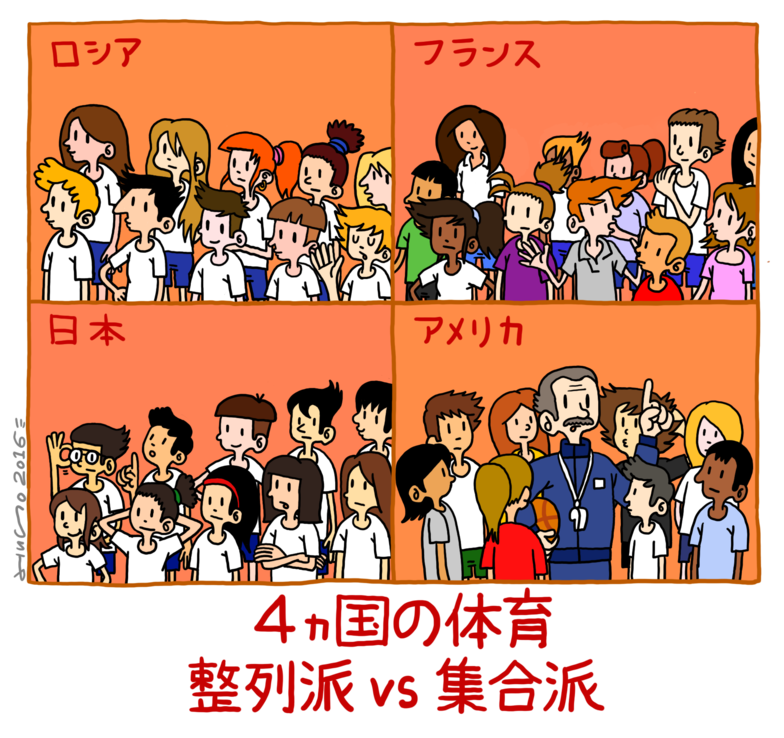When gym class starts, everyone lines up neatly in a single file. Why is that? It puzzled me for a long time.
My first physical education class arrived after starting elementary school in Russia. The teacher instructed us to line up in a single file by height. Where would I be? Everyone compared heights, splitting left and right to form a line. After some adjustment, I ended up at the very front. Yes, the very front. The position where I had to lead everyone.
In first grade, I was the tallest in my class. That's why I ended up at the front. Huh? You might be thinking, "But can't the people behind see?" But in Russia, the tallest person goes in front.
Why? I think one reason is that being tall, especially in the lower grades of elementary school, often indicates physical and mental development, which frequently translates to good athletic ability. In other words, tall children can serve as role models for everyone. Everyone strives to be like that person. This applies both to ability and as a motivational reminder: "I want to be tall! I want to be further forward!"
In Russia, the best being at the very front is a perfectly natural progression. There's a special allure to being "first" or "at the very front." This tendency was visible even in kindergarten. For example, during dance time. Boys and girls would pair up to dance, and here too, the best pair danced at the very front. During singing time, the best singer sang at the front.
Being at the front simply meant you were valued. The idea was that those at the back, unable to see what was happening, would feel frustrated and push themselves harder. It was always a competition.
When I transferred to an elementary school in Japan, I suddenly found myself at the very back of the line. Yes, my position was suddenly reversed. I was tallest, so why was I at the back? At first, I was a little dissatisfied. Especially since my strongest subject was physical education, I couldn't understand it.
I was completely hidden from the teacher's view, buried in the crowd even during radio calisthenics. This system puzzled me for a while. But then the teacher explained: "If you come to the front, you won't be able to see everyone, right? And it would be harder for the people in the back to improve, wouldn't it?"
Ah, I realized. Here, "consideration" is valued. Being tall is just a feature. Sports here seemed more team-oriented, and winning hinged on how well the team worked together. Motivating weaker members to boost the team's strength also became important. Who was the best wasn't that crucial. Somehow, it felt like PE embodying the spirit of "All for One, One for All."
But there's one thing about Japanese PE that's always puzzled me. Why do they write names so big on gym uniforms? You'd think they'd remember their classmates' names. It really is baffling.
After transferring to an American elementary school, the much-anticipated PE class arrived. There was no designated gym uniform; everyone changed into whatever comfortable clothes they had. I wondered, "What number would I be here?" I was a little excited, but it turned out there was no concept of lining up here.
The children sat cross-legged around the teacher. The teacher explained. Even during stretches, they stayed in that formation. Height or athletic ability didn't matter. I didn't sense any reluctance toward PE from anyone. As the grades got higher, physical builds varied considerably. But here, the goal of PE was simply to enjoy moving your body. It was never a place for competition or showing off athletic skills.
At first, I wasn't used to this style, but learning the concept of "sports for fun" allowed me to find enjoyment in sports beyond competition. This was fun in its own way.
Those who wanted to pursue sports seriously joined clubs outside school to learn soccer, basketball, baseball, and so on. Little League, as it's called. There, they were thoroughly taught technique and team play. I belonged to a basketball team for a short time too; it was somewhat similar to Japanese school clubs, with serious coaching.
Changing sports to suit the purpose and location like that was really interesting. Maybe that's what they mean by "choose a worthy opponent if you're going to compete!"
Come to think of it, when I transferred to a French elementary school, they didn't even have the concept of lining up, let alone gym uniforms or a gymnasium. Instead, we changed into comfortable clothes suited for whatever sport we were learning that period and went together to the appropriate facility: the pool, a court, a park, the schoolyard. Here too, the focus was on moving our bodies, with few competitive sports.
Take swimming, for example. The lesson's goal wasn't necessarily to swim well, but simply to get comfortable in the water. So instead of lanes, the pool had big floating toys. Swimming out to them and playing with them was that day's PE. Another day, we all went to a nearby court and played flying disc.

Through this wordless physical education, everyone opened up to each other. Playing together even seemed to foster a sense of camaraderie among classmates from various countries. Indeed, moving our bodies together did seem to close the distance a little.
Should we line up? Or not? In what order? Is the purpose of PE to learn discipline, improve individual athletic ability, build teamwork, or simply enjoy moving our bodies? Just considering these four aspects alone makes me feel like my image of PE changes significantly.
Looking at it this way, perhaps physical education—nonverbal and not an exam subject—is actually the perfect subject for experimenting with different teaching approaches. Thinking about it that way, a form of physical activity suited to the 21st century seems to come into view. It's very intriguing.




